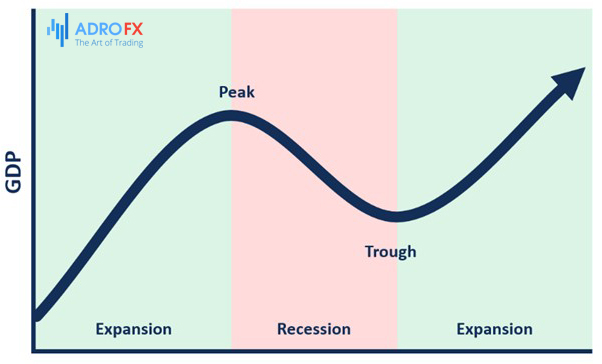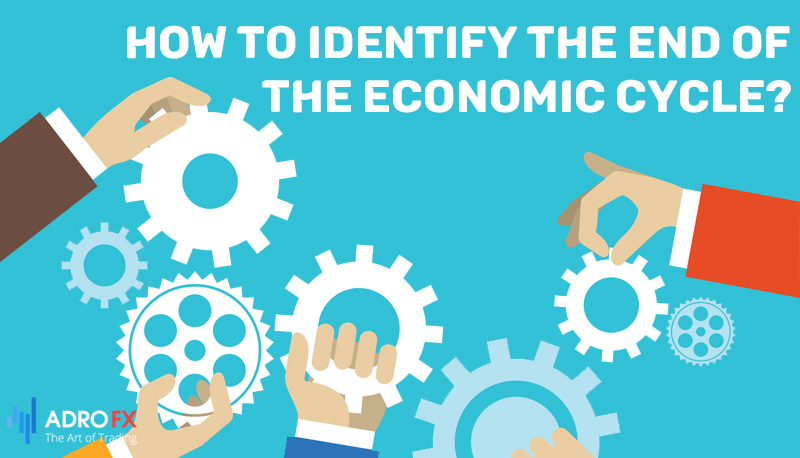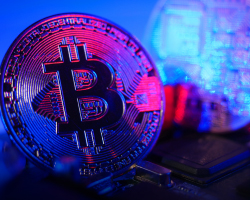What Is the Economic Cycle? Stages & Importance

Probably every trader or investor has been caught in what is known as a market bubble. But it is only one of the many phases of the market. To avoid falling into this trap in the future, you must clearly understand the cyclic nature of the market, understand its characteristics and be able to analyze further price behavior. If you have technical analysis skills and knowledge about cycles you can detect the appearance of bubbles in time and avoid them.
The Origin of the Economic Cycle Theories
Economic cycle theories began to emerge in the mid-19th century. Prior to that, crises also occurred, but they were sectoral and were not associated with cyclicality. They were caused by external shocks such as wars, natural disasters, or crop failures. The first identified cyclical crisis is considered to have occurred almost two hundred years ago, in 1825, in England. What was unusual was, first of all, that the recession occurred during peacetime. Secondly, everyone was struck by the scale of the crisis: it began in one sector, and then it spread to the entire British economy. However, its cyclical nature was revealed after two more crises, when it was found that they recurred every 11 years.
The French economist C. Juglar was the first to use the term "cycle" in his 1860 essay on the regularity of trade crises in England, France, and the United States. He identified three phases of the cycle: prosperity, crisis, and depression. Relying on statistical data, Juglar tried to establish a relationship between interest rates, bank reserves, commodity prices, and commercial credit to determine the impact of these indicators on the changing phases. At the same time, the question of the causes of the cycle was not considered.
At the beginning of the twentieth century, N. Kondratieff developed the theory of great cycles. Having analyzed statistical data from the end of the 18th century, he identified two complete and one incomplete cycle of up to 60 years. At the transition from one economic cycle to another, namely at the beginning of the boom phase, technical inventions are massively introduced. Subsequently, many researchers began to link the "Kondratieff waves" with the change in technological modes.
What Is an Economic Cycle?
Economic or business cycles are understood as fluctuations of economic activity, which consist of the change of periods of recessions and rises. This is reflected in changes in employment, output, and inflation, with consequences for both the general population and private companies.
Cycles are periodic, but not regular. They do not necessarily recur at a certain interval. The duration and amplitude of fluctuations in different cycles can vary greatly. On average, it is believed that periods can last from two to ten years.
Why the Economy Evolves in Cycles
Right now the cycle is characterized as a random, hard-to-predict process. However, there are recurring relationships between various economic variables. Therefore, the cycle is viewed primarily as a response of the economic system to a set of external and/or internal impulses.

Unpredictable events, which are the causes of growth or decline in the economy, are called shocks. They can be both favorable for the economy, such as technological progress, and breakthrough innovations, and unfavorable, including epidemics, natural disasters, and wars.
The amplitude and duration of the cycle depend on the properties and strength of the shock, as well as on the government actions that followed in response. Because the economy is exposed to impulses at random time intervals, some economists think it is more correct to use the word fluctuations instead of cycle.
Stages of the Economic Cycle
The four main stages of the economic cycle are most commonly identified: expansion, peak, contraction, and trough. The cycle period itself is the time interval between two identical states on the curve (peaks or troughs).
The change of phases consists of fluctuations of the main macroeconomic indicator reflecting the results of economic activity - gross domestic product (GDP). During periods of ups and downs, there is a deviation between real indicators of economic activity from potential ones. In this case, potential GDP, or economic potential, is used as the main average indicator. It shows the output at full employment of resources.

In fact, full employment of resources does not mean the use of 100% of production capacity and involvement of all labor resources. For example, the calculation of potential GDP assumes that production facilities are utilized at 80-90% of their total capacity, and that unemployment remains at its natural level (6-7% of the total labor force).
The following stages of the economic cycle are distinguished:
- Expansion is a period of growth in economic activity from the low point of the cycle to the high point. It is characterized by an increase in employment and income, investment, as well as moderate inflation. Demand for non-essential goods pent up during the previous downturn is realized.
- Peak is the upper phase of the cycle, which is reached when resources are fully employed. Production capacity is utilized as efficiently as possible, and the unemployment rate corresponds to the natural rate. The disposable income of the population grows, and inflation accelerates.
- Contraction, or recession, is a period of declining economic activity from the high point of the cycle to the low point. Output, investment, and employment decrease. At the same time, inflation can be multidirectional. For example, if a lot of goods are produced and people have little income, the general price level and inflation may fall. The term "economic crisis" is used synonymously with a downturn or recession, or as a reference to the acute phase of the cycle. Statistically, a recession is recorded if GDP declines for two consecutive quarters. A deep recession lasting more than two years is called a depression.
- Trough is the lowest point of decline in business activity, in which the use of material and labor resources in production is minimal and the decline in production and sales is maximal. During this period, there is a high level of unemployment and a general drop in the income of the population. The trough phase is short-lived and is usually recorded post-factum.
The Impact of Economic Cycles on Businesses
During economic downturns, output, investment, and employment decline. There is also a drop in final demand from the population.
The cyclical nature of the economy in terms of output and goods production has the greatest impact on the market for durable goods and capital goods. Companies whose cash flows are heavily dependent on the phases of the economic cycle are called cyclical. This includes, for example, the automobile, steel, and construction industries. Their earnings rise during economic upswings and fall during recessions much more than in industries producing short-term goods.
Economists offer two explanations for this:
- During recessions, almost all companies curtail investments in new projects or equipment upgrades. The population acts in the same way: the purchase of expensive goods is postponed until better times. Therefore, employment in cyclical industries declines and output falls;
- Such industries engaged in the production of means of production and durable goods are usually characterized by an oligopolistic market structure due to the presence of a small number of players. This allows them not to reduce the price during periods of downturns in business activity, and reduce output and employment.
Thus, the impact of business cycles on companies is heterogeneous. An investor will demand a higher rate of return on investment in cyclical companies, whose value is more dependent on the stage of the economy.
Classification of Economic Crises
There are many classifications of crises:
- by scope (scale) distinguish local, regional, and global crises; by duration - protracted and temporary;
- by periodicity, crises are included in one of the following cycles: Kondratieff's Big Wave (40-60 years), Kuznets cycles (15-23 years), Juglar cycles (5-8 years), or Kitchin cycles (2-4 years)
- by nature - acute and mild, explicit and latent, predictable and unexpected;
- by causes - natural disasters, scientific and technological progress, government actions, human psychology, etc.
There are examples in the world history of deep crises and markets falling by more than 50% - for example, the 1973 oil shock, Argentina's defaults, and the effects of sanctions on Iran. However, the stock market continued to work, and a downturn was always followed by a recovery. Historical data proves that the long-term trend of GDP tends to grow. Thus, the crisis will be followed by economic recovery, with the bottoms and peaks shifting higher and higher over time.

How to Identify the End of the Economic Cycle?
If we consider the cycle as a period from one peak to the next, the main indicator of the end of the cycle will be a slowing down of the economy. Sometimes this process is referred to as a separate phase of the economic cycle, after which the economy slides into recession.
While it is difficult to predict exactly when the cycle will end, there are several indicators that can suggest an economic downturn is imminent.
One of the main indicators is a decrease in GDP growth. When the economy slows down and GDP growth rates begin to decline, it can be a sign that the end of the economic cycle is near. Another warning sign is a rise in unemployment rates as businesses cut back on hiring or lay off workers.
Additionally, a drop in consumer confidence can indicate that the end of the cycle is approaching.
When consumers become pessimistic about the economy and their financial future, they tend to reduce their spending, which can further slow down economic growth.
Other indicators that suggest the end of the economic cycle include a decrease in industrial production, a decline in the stock market, and an increase in interest rates. Rising interest rates can make it more expensive for businesses to borrow finances, which can lead to reduced investment and slower economic growth.
When observing a slowdown in economic activity, some investors try to increase their share of capital in safe-haven assets (gold) or non-cyclical sectors of the economy. The latter may include areas such as utilities, health care, and consumer staples.
Investors, funds, and governments monitor a number of leading indicators to better gauge the health of the economy. Among them is the volume of production orders, oil prices, stock indices, etc.
However, the most frequently used are integral business cycle indices which include several individual leading indicators with certain weights. This approach, proposed back in the early days of business cycle research, continues to be one of the most effective today. Such indices are calculated by national statistical bureaus. Investors are looking at their indicators and are drawing appropriate conclusions.
It is important to note that while these indicators can be useful in predicting the end of the economic cycle, they are not foolproof. Economic cycles can be influenced by a wide range of factors, including government policies, international trade, and technological innovation. Therefore, it is important to keep an eye on these indicators and also to monitor other factors that may impact the economy.
How to Apply Economic Cycles in Investment Strategy
One of the steps in selecting tools for investment is assessing the macroeconomic background of the company, including determining the phase of the business cycle and its impact on the relevant area of activity. During the recession caused by the coronavirus pandemic, for example, industries such as travel, transportation, and automotive were the hardest hit. Demand for their goods and services shrank to a minimum, and companies showed losses.
At the same time, the pharmaceutical industry and the production of medical devices and equipment benefited from the crisis. If we consider monetary policy, the investor should keep in mind that the transition to a cycle of rising interest rates is favorable for the banking sector. Conversely, a rate cut has a negative impact on bank stocks due to their shrinking margins.
About AdroFx
Established in 2018, AdroFx is known for its high technology and its ability to deliver high-quality brokerage services in more than 200 countries around the world. AdroFx makes every effort to keep its customers satisfied and to meet all the trading needs of any trader. With the five types of trading accounts, we have all it takes to fit any traders` needs and styles. The company provides access to 115+ trading instruments, including currencies, metals, stocks, and cryptocurrencies, which make it possible to make the most out of trading on the financial markets. Considering all the above, AdroFx is the perfect variant for anyone who doesn't settle for less than the best.










